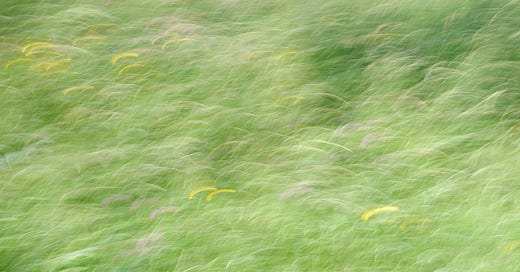What did you hear last week?
I live in a small town with an older population, so it’s generally very quiet. On a regular basis, I hear some traffic noise, occasional sirens, birdsong, and honking geese. I hear water lapping and wind blowing and people talking. At this time of year, the sounds of motorized lawn equipment revs up. Recently, there has been construction of a new house two doors down so the sounds of banging and hammering have added an extra layer to the symphony.
Are you getting a sense of the unique soundscape of your place?
Last week, I asked you to notice sound by way of three acoustic sources, as defined by Bernie Krause. (Anthropocene Magazine). This week, we’ll focus more narrowly, on the geophony of place - the nonbiological natural sounds, like wind in the trees or grasses, water in a stream, waves at the ocean shore. In his book, How to Read Water, author Tristan Tooley has a fascinating chapter on the sound of water. And he says that how we hear the sound of anything is highly dependent on many invisible factors.
“The sounds we hear outdoors are affected by the wind, the way the sounds spread out and are absorbed by the air, the shape of the ground, any obstacles, and the air pressure, temperature, and humidity.”
For example, Tooley says that flat, open ground and cold air allow sounds to travel further. Sound waves also travel further over water than they do on land. Low-frequency (deep) sounds travel around and through obstacles more easily. Higher-frequency sounds are more likely to be reflected (bounced) by things in their way.
No need to get super technical here. Just notice when a sound arises, how long it lasts, its duration, how it changes, and when you can’t hear it anymore. In her book, Mind your Life, Meg Salter recommends saying “hear” when you notice a sound and then “gone” when it disappears. This is a great way to notice the absence of sound or the space between sounds.
Practice
Take time each day to listen for the non biological sounds of wind and water, whether while on a walk or sitting outside.
Tooley suggests closing your eyes and twisting your head slowly as far as you can in either direction. Listen for sounds and where they’re coming from. Feel the direction of the air or wind. When you’re confident of the direction of a sound, point in that direction and only then open your eyes.
Back in February, I asked you to map your place in terms of your watershed, or the way the water flows to its source. You can also make a sound map of your place by noting when you begin to hear the sound of water and how it’s determined by its surroundings and conditions.
Notice how the sound of your feet hitting the ground changes depending on the topography and the surface.
Notice how sounds change as you go through different landscapes, i.e. a field versus a forest, city life and a more secluded park, day and night.
** Optional: Record sounds on your phone.
Resources
Synaesthesia and Seeing Sound - this is a post I wrote after entering a call for photographic submissions on seeing sound. A very interesting exercise for the photographers among you.
Listen to soundscapes by Patrick Harlin.




